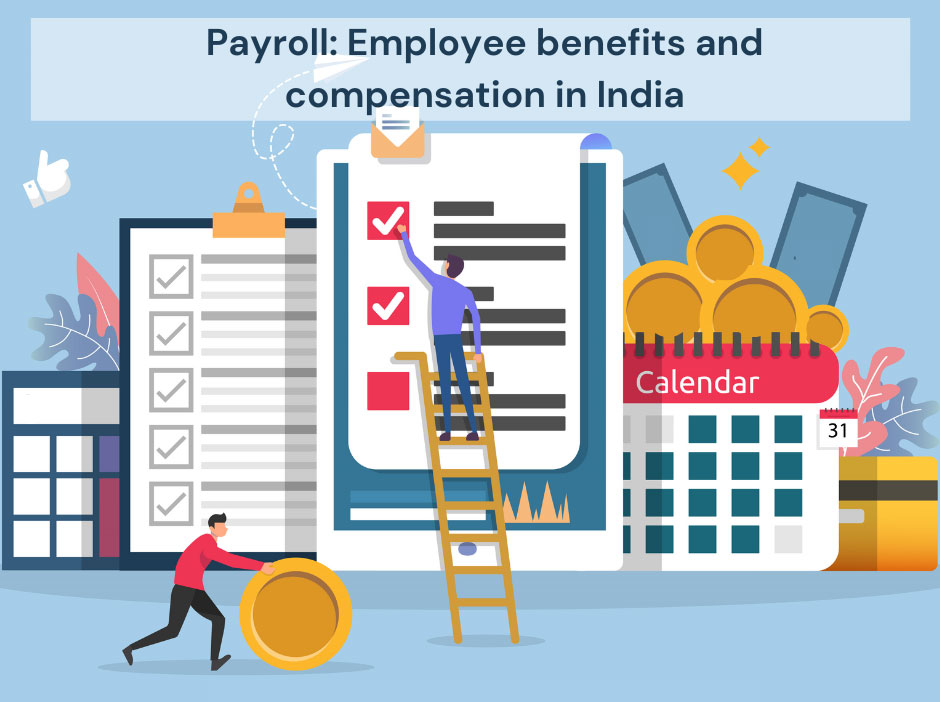Payroll: Employee benefits and compensation in India
In India, employee benefits and compensation are significant aspects of the overall employment package. The structure can vary across industries, companies, and job roles, but there are some common elements.
“Payroll in India involves the management of employee benefits and compensation. This encompasses various elements such as basic salary, allowances, variable pay, and statutory components. Basic salary forms the fixed part of an employee’s compensation, while allowances like House Rent Allowance (HRA) and Dearness Allowance (DA) provide additional financial considerations. Variable pay, often tied to performance, adds a dynamic component to the overall compensation. In parallel, statutory components include contributions to the Provident Fund (PF), Gratuity, and compliance with Employee State Insurance (ESI) and other labour laws. Employee benefits further enrich the compensation package. These can include health insurance, retirement benefits, paid leave policies, and stock options. Combining these elements reflects the holistic approach businesses take in India to reward and support their workforce.”
Employee Compensation:
- Basic Salary:This is the fixed component of an employee’s salary and is usually a major part of the overall package.
- Allowances:Various allowances such as House Rent Allowance (HRA), Dearness Allowance (DA), and Travel Allowance may be provided based on company policies and government regulations.
- Variable Pay:Many companies offer performance-based bonuses or incentives tied to individual or company performance.
Employee Benefits:
- Provident Fund (PF):Both the employer and the employee contribute to the Provident Fund, a mandatory savings scheme for employees.
- Gratuity:A lump sum payment made by employers to employees as a token of appreciation for their long-term service.
- Insurance:Companies may provide health insurance, life insurance, and other insurance benefits to employees.
- Leave Policies:Employees are entitled to various types of leaves, including casual leave, sick leave, and earned leave.
- Employee Stock Options (ESOPs):Some companies offer employees the option to buy company shares at a discounted price.
- Retirement Benefits:Employers may contribute to the Employee Pension Scheme (EPS) or offer other retirement benefits.
Statutory Requirements:
- Minimum Wages:Employers must adhere to the minimum wage regulations set by the respective state governments.
- Gratuity:Employers are required to provide gratuity to employees who have completed a certain number of years in service.
- Employee State Insurance (ESI):For certain categories of employees, employers need to contribute to the ESI scheme, providing medical and cash benefits.
It’s important for employers to stay updated on changes in labor laws and regulations to ensure compliance and offer competitive packages to attract and retain talent.
Read more: (All You Need to Know about the Taxable, Nontaxable, and Partially Taxable Components of Salaries and Allowances)
Objectives of Compensation and Benefits Management
There can be a contrast in the views of employees and employers concerning C&B. While employees would negotiate to get a higher pay package, employers would like to save a lot on their allocated budget for a particular position. Therefore, compensation management should aim to address and fulfil the needs of the employees and employers to come to a consensus. The objectives of an excellent C&B plan are:
- Compensation must satisfy the employees’ general requirements and expectations for the work performed.
- To create a competent and fair compensation strategy to assist in recruiting qualified talent and reward achievement.
- To help prevent talent drain from the organization.
- To aid in improving a company’s ranking on digital platforms in terms of employee satisfaction and motivation
- To design the compensation and benefits according to India’s legal provisions, labor laws, and the Minimum Wages Act of 1948. As per the Wages Act 2019, workers from all industries are entitled to receive minimum wages fixed by their respective state governments.
- To control the overall cost to the company (CTC).
Types of Compensation:
Typically, employees take compensation as synonymous with salary. Compensation can be monetary or non-monetary, known as direct or indirect benefits.
1. Direct Compensation
This involves direct monetary benefits given to the employees. This mainly includes employee salary and variable pay for work. Other direct components include monetary forms of compensation given below.
Monetary forms of compensation include:
- Salary
- Bonus
- Profit share
- Sales incentives
- Monetary rewards
- Overtime payment
- Retirement pay
- Allowances
2. Indirect Compensation
Indirect compensation does not involve direct and fixed money transfers to employees. Apart from a fixed salary, employees are given various types of allowances, reimbursements, and benefits that are not fixed. Examples of indirect compensation are given below.
- Medical reimbursement
- Mobile phone usage reimbursement
- Internet Reimbursement
- Fuel reimbursement
- Health Insurance
- Life Insurance
- Stock options
- Company-paid accommodation
- Company vehicle for office use
- Scholarships for courses
- Promotion opportunity
- Shifting to a desired role or location
- Other forms of public recognition
- Overtime pay
- Passes, tickets, or coupons to movies, matches, or shopping
- Retirement benefits such as pension plans
- Gratuity
- Transportation
All the reimbursements are to be claimed by the employees and approved by their supervisor. Other components, such as compensatory off, paid holidays, free lunch, etc., can also be a part of the compensation and benefits package. One employment may be a better financial proposition than the other even when two occupations offer the same salary due to differences in the indirect compensation or benefits package.
Read more: (Maximizing Efficiency: The Benefits of Payroll Outsourcing)
Mandatory Benefits in India
The employment benefits that are considered a must-offer to keep employees motivated at the workplace are given below.
Health Insurance: As a part of the health insurance benefits policy, employers are mandated to provide medical insurance to their employees. Generally, this policy covers the employee, spouse, and kids. Employers can also offer extensive plans to cover an employee’s parents as well.
Gratuity: As per the payment of the Gratuity Act 1972, every employee is entitled to gratuity. Gratuity is a sum of money paid by an employer to an employee for services rendered in the company. The gratuity amount is equal to one-fourth of the last-drawn basic salary of an employee for each completed six-month period.
Employee’s Provident Fund (EPF) : The employee’s provident fund in India is governed by the Employees’ Provident Fund and Miscellaneous Provision Act, 1952.
Employee contribution:As per the Act, employers should determine 12% of employees’ Basic pay + Dearness allowance to EPF. Employees may also choose to contribute 24% of the EPF.
Employer contribution:Employer contribution is designated as 12% of the employee’s Basic pay + Dearness allowance, out of which 8.33% goes to the employee pensions scheme (EPS), and the remaining 3.67% goes to the employee provident fund (EPF) account.
Leaves and holidays: Leaves and holidays include benefits of paid time off for employees for annual holidays, maternity leaves, and sick leaves.
Workplace security: The service laws of organizations must provide a healthy workplace for employees. Companies must ensure the protection of employees from all kinds of harassment, such as sexual harassment of women (covered under the Sexual Harassment of Women at Workplace Act 2013).
Payroll benefits encompass additional compensation and perks offered to employees beyond their standard salary. These perks comprise health insurance, retirement plans, paid time off, and similar offerings. Payroll and benefits is derived from a mix of contributions from the employer and deductions from the employee’s earnings. Certain benefits, such as unemployment insurance, are mandatory as per legal requirements, while others, like allowances for commuting or working from home, are voluntarily provided by employers to attract and retain skilled professionals.
Payroll and employee benefits are integral components of an organization’s compensation structure. Let’s explore each one:
Payroll:
- Salary and Wages: Payroll encompasses the calculation and distribution of salaries and wages to employees based on their employment contracts.
- Deductions and Withholdings: It includes deducting taxes, employee contributions to benefits, and other withholdings as required by law or company policies.
- Tax Compliance: Ensuring compliance with local and state tax regulations, including accurate calculation and timely submission of taxes.
- Direct Deposits and Payroll Processing: Managing the process of transferring funds directly into employees’ bank accounts through direct deposits or issuing physical paychecks.
- Record Keeping: Maintaining accurate records of employee compensation, taxes, and other payroll-related information for auditing and reporting purposes.
- Compliance with Labor Laws: Adhering to labour laws and regulations regarding minimum wages, overtime pay, and other legal requirements.
Employee Benefits:
- Health Insurance: Providing healthcare coverage to employees, which may include medical, dental, and vision insurance.
- Retirement Benefits: Offering retirement plans and pension schemes to help employees save for their future.
- Paid Time Off (PTO): Granting paid leave for vacation, holidays, and personal days to ensure a work-life balance.
- Life and Disability Insurance: Providing financial protection to employees and their families in the event of death or disability.
- Employee Assistance Programs (EAPs): Offering counselling services and support to employees for personal or work-related challenges.
- Tuition Reimbursement: Supporting employees in their professional development by bonuses and Incentives. Providing performance-based bonuses or incentives to recognize and reward employees for their contributions.
Payroll services provide a range of benefits, from increased efficiency and accuracy to cost savings and improved compliance, allowing businesses to streamline their payroll processes and enhance overall operational effectiveness. Using a payroll service offers various advantages for businesses. Here are some key benefits of payroll services:
- Time Efficiency: Payroll services automate time-consuming tasks, saving businesses valuable time in calculating salaries, deductions, and tax obligations.
- Accuracy and Compliance: Professional payroll services reduce the risk of errors in payroll processing and ensure compliance with constantly changing tax laws and regulations.
- Cost Savings: Outsourcing payroll can be cost-effective, eliminating the need for investing in expensive payroll software, training, and the manpower required for in-house processing.
- Focus on Core Business Activities: By outsourcing payroll, businesses can redirect their focus and resources toward core activities, fostering growth and strategic development.
- Security and Data Confidentiality: Payroll service providers implement robust security measures to safeguard sensitive employee information, reducing the risk of data breaches.
Wrap-up:
Effective management of both payroll and employee benefits contributes to employee satisfaction, retention, and overall organizational success. It’s a delicate balance that ensures fair compensation and a supportive work environment.










